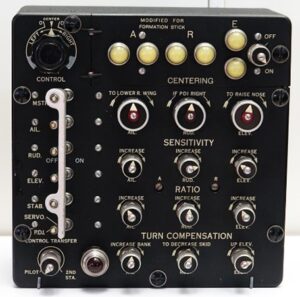
Genesys Blog
The Evolution of Aircraft Autopilots: From Basic Systems to Advanced Technology
Aircraft autopilots have become an integral part of modern aviation, revolutionizing the way pilots fly and enhancing safety in the skies. These systems are designed to reduce pilot workload and provide precise control over the aircraft’s flight path. In this article, we will explore the evolution of aircraft autopilots, from their humble beginnings as basic systems to the advanced technology we see today.
The Early Days: Basic Autopilot Systems
In the early days of aviation, aircraft required the continuous attention of a pilot to fly safely. As aircraft range increased, allowing flights of many hours, the constant attention led to serious fatigue. An autopilot is designed to perform some of the pilot’s tasks to reduce fatigue, which results pilot error. Early autopilot systems were rudimentary analog electro-mechanical systems and primarily focused on maintaining a steady flight path. These early systems were mechanical in nature and lacked the sophistication of modern electronic counterparts flown today. They were designed to perform basic functions such as altitude hold and heading control, allowing pilots to maintain a stable flight without constant manual input. However, these systems had their limitations, relying heavily on mechanical components that were prone to wear and tear and required frequent maintenance activities.

For example, The first aircraft autopilot was developed by Sperry Corporation in 1912. The autopilot connected a gyroscopic heading indicator and attitude indicator to hydraulically operated elevators and rudder. It permitted the aircraft to fly straight and level on a compass course without a pilot’s attention.
As capabilities increased in autopilots, different levels of axis controls could be selected. There are three levels of control in autopilots, a single-axis autopilot controls an aircraft in the roll axis only; such autopilots are also known as “wing levelers”. A two-axis autopilot controls an aircraft in the pitch axis as well as roll. A three-axis autopilot adds control in the yaw axis.
Advancements in Automation: Flight Director Systems
As aviation technology progressed, the introduction of flight director (FD) systems brought about significant advancements in aircraft automation. Flight director systems provide pilots with guidance cues to visually follow during flight, displayed on the aircraft’s primary flight display (PFD). These cues help pilots maintain the desired flight path, making navigation more precise, and reducing the chances of human error. The integration of flight director systems with autopilots allowed for even greater control and enhanced situational awareness. Pilots could now rely on these systems to manage their flight path more effectively, resulting in improved flight safety.

The Digital Revolution: Computer-Based Autopilots
With the advent of digital electronics, aircraft autopilots underwent a significant transformation. Computer-based autopilots replaced their mechanical predecessors, offering enhanced performance, reliability, and functionality. These systems utilize digital algorithms and sensors to monitor and control the aircraft’s flight parameters. Advanced features such as vertical navigation (VNAV) and lateral navigation (LNAV) were introduced, allowing for precise altitude and lateral control. VNAV and LNAV functionality integration allowed more complex approach and landing patterns during limited visibility conditions. Autopilots became integrated with other avionics systems, such as GPS and inertial navigation systems (INS), further enhancing their accuracy and reliability. Pilots could now rely on these computer-based autopilots to navigate complex flight routes with ease.

Fly-by-Wire Technology: The Future of Autopilots
Fly-by-wire technology represents the future of aircraft automation and autopilot systems. This technology replaces traditional mechanical controls with electronic signals, allowing for more precise and efficient flight control. Fly-by-wire systems are integrated with autopilots, enabling advanced flight control capabilities. These systems offer improved maneuverability, reduced system weight, and enhanced safety features. By eliminating the need for mechanical linkages, fly-by-wire technology allows for greater flexibility in aircraft design and opens the door to potential advancements in autopilot technology. The future will also likely see the integration of artificial intelligence (AI) and autonomous flight capabilities, further reducing pilot workload and enhancing flight safety.
Conclusion:
The evolution of aircraft autopilots has come a long way, from basic systems focused on maintaining a steady flight path to advanced technology that offers precise control and enhanced safety features. Autopilots have significantly reduced pilot workload, allowing them to focus on other critical tasks during flight. The continuous development of autopilot technology promises even greater advancements in the future, with the potential for artificial intelligence and autonomous flight capabilities. As aviation technology continues to evolve, autopilots will remain a crucial component in ensuring safe and efficient flights for pilots and passengers alike.
About Genesys Aerosystems, a Moog Inc. Company
Genesys Aerosystems is a leading provider of integrated avionics systems for military and civil customers. Genesys Aerosystems’ avionics systems are offered individually and integrated to provide an entire cockpit solution. Its synthetic vision Electronic Flight Instrument System (EFIS) revolutionized safety in low-level flight operations for both fixed-wing and helicopter aircraft makes and models. Genesys Aerosystems’ VFR and IFR approved autopilot solutions are certified and available on many fixed-wing and helicopter aircraft makes and models. For more information, visit www.genesys-aerosystems.com.
About Moog Inc.
Moog is a worldwide designer, manufacturer, and systems integrator of high-performance precision motion and fluid controls and control systems. Moog’s high-performance systems control military and commercial aircraft, satellites, and space vehicles, launch vehicles, defense systems, missiles, automated industrial machinery, marine, and medical equipment. Additional information about the Company can be found at www.moog.com.